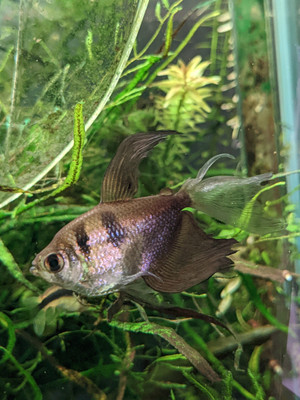Sunday Species Spotlight: Black Skirt Tetra/GloFish (Gymnocorymbus ternetzi)
Posted by Crystal Chan on on 24th Sep 2022
Black Skirt Tetra/GloFish (Gymnocorymbus ternetzi)
IUCN Conservation Status: Not Evaluated
Ecology
A staple fish in the aquarium hobby, this fish originates from the Paraguay and Guaporé River Basins in Argentina but has since expanded into other parts of South America and Southeast Asia, where it is aquacultured for the aquarium hobby. In the wild, this fish swims around the middle and upper layers of the water and eats small critters like worms and insects. [1]
Fishery
The Black Skirt Tetra has a very interesting contribution to the aquarium hobby as it is often found not just as its wild type, but also as the GloFish Tetra! In the early 2000’s, scientists added fluorescent* genes from marine animals to the zebrafish and found that fish with those genes would display bright, neon colors. [2] There was some initial concern about these genetically modified fish negatively affecting the local wildlife and ecosystem, but after multiple studies found that the GloFish variants of this fish in the United States were unable to survive in the wild, these fluorescent versions of the Black Skirt Tetra were allowed to be sold in California in 2015. [4, 5] More studies have been done since then and continue to confirm this finding. [3]
In Aquaria
For both the Black Skirt Tetra and the GloFish Tetra, care is relatively simple. This fish is not a picky eater, and is fairly hardy and good for beginner fish keepers. However, it does best in schools and can be semi-aggressive towards other fish, so it’s not recommended to keep this fish with slower moving or long tailed species. A tank size of at least 20 gallons is required to keep a small group. [6]
Fluorescent: a vivid color produced by something that has absorbed and is emitting light, usually UV light
Citations
[1] Mills, D., & Vevers, G. (1989). The Tetra encyclopedia of freshwater tropical aquarium fishes. Tetra Press.
[2] National Center for Biotechnology Information (2022). PubChem Patent Summary for US-2018064074-A1. Retrieved September 17, 2022 from https://pubchem.ncbi.nlm.nih.gov/patent/US-2018064074-A1.
[3] Leggatt, R. A., & Devlin, R. H. (2020). Fluorescent protein transgenesis has varied effects on behaviour and cold tolerance in a tropical fish (Gymnocorymbus ternetzi): implications for risk assessment. Fish physiology and biochemistry, 46(1), 395–403. https://doi.org/10.1007/s10695-019-00725-3
[4] Hill, J. E., Lawson, L. L., & Hardin, S. (2014). Assessment of the Risks of Transgenic Fluorescent Ornamental Fishes to the United States Using the Fish Invasiveness Screening Kit (FISK). Transactions of the American Fisheries Society, 143(3), 817–829. https://doi.org/10.1080/00028487.2014.880741
[5] State of California Department of Fish and Wildlife. (2015). Subject: Sales of GloFish in California [White paper]. State of California. https://web.archive.org/web/20161221011758/http://www.fgc.ca.gov/meetings/2015/Apr/Exhibits/21A_1_LTR_Glofish_CA_BonhamChuck.pdf
[6] Gymnocorymbus ternetzi Black Widow Tetra. (n.d.). Seriously Fish. https://www.seriouslyfish.com/species/gymnocorymb...

